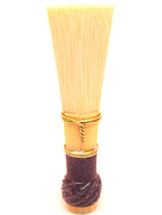Quick Link:
The reed is one of the most important factors affecting tone. Oboes and bassoons use a "double reed," meaning there are two reeds vibrating against each other to produce a tone. These two reeds, made from Arundo Donax cane, are tied onto a metal tube called a "staple," and the staple's cork is inserted into the oboe (or onto a bocal for bassoon and English horn).

The Ever-Changing Reed:
The natural fibers of a reed are easily affected by moisture/saliva, mouth pressure, temperature/weather, and time, which causes the reed to be in a constant state of change. Brand new reeds need to be "broken in" for a week. Each reed has its own set of strengths and weaknesses, and even these change over time. I can adjust your reed as needed to keep it at its best.
The natural fibers of a reed are easily affected by moisture/saliva, mouth pressure, temperature/weather, and time, which causes the reed to be in a constant state of change. Brand new reeds need to be "broken in" for a week. Each reed has its own set of strengths and weaknesses, and even these change over time. I can adjust your reed as needed to keep it at its best.
Reed Care:
Note to beginners: It is perfectly normal for beginners to break reeds a lot during the first few months of playing. Chipping corners are usually due to accidentally hitting the reed on things, and center cracks are usually due to biting too much while playing. Tip cracks are often caused by playing with too much reed inside the mouth. It takes some time to learn the balance between muscle/air and to develop an embouchure that does not bite the reed.
Click for info about making oboe reeds.
- Soak the reed for 1-2 minutes in water, not your mouth. Saliva will break down the reed faster, and you need water to soak the inside of the reed too.
- Store your reeds in a reed case, not the shipping tubes. This will prevent accidental cracking and mold growth.
- Always use a "round and tall" embouchure with your teeth apart. Biting the reed in the center will flatten it, and you'll surely sound like a mallard.
- For oboists, only put the minimal amount of reed possible inside your mouth. Using too much reed will result in a closed, flattened, and possibly cracked reed, as well as quacky tone.
- When walking around, carry the reed in your mouth or in a case.
- Never lay the oboe sideways with the reed still attached.
- You can clean your reeds by running water through them after playing. Diluted mouthwash or hydrogen peroxide can help disinfect them (rinse your reeds immediately after using H2O2).
Note to beginners: It is perfectly normal for beginners to break reeds a lot during the first few months of playing. Chipping corners are usually due to accidentally hitting the reed on things, and center cracks are usually due to biting too much while playing. Tip cracks are often caused by playing with too much reed inside the mouth. It takes some time to learn the balance between muscle/air and to develop an embouchure that does not bite the reed.
Click for info about making oboe reeds.



